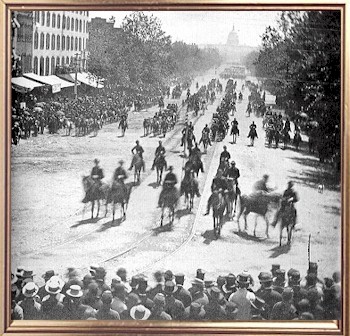THE GRAND REVIEW
 Over a Two-day period in Washington, D.C., May 23-24, 1865, the immense, exultant victory parade of the Union's main fighting forces in many ways brought the Civil War to its conclusion. With the nation's new president, Andrew Johnson, declaring on May 10 that all armed resistance was "virtually at an end," plans commenced for the review. It would far eclipse the two victory celebrations held before the assassination of Abraham Lincoln and bring Washington out of its formal mourning period for the slain president.
Over a Two-day period in Washington, D.C., May 23-24, 1865, the immense, exultant victory parade of the Union's main fighting forces in many ways brought the Civil War to its conclusion. With the nation's new president, Andrew Johnson, declaring on May 10 that all armed resistance was "virtually at an end," plans commenced for the review. It would far eclipse the two victory celebrations held before the assassination of Abraham Lincoln and bring Washington out of its formal mourning period for the slain president.
William Tecumseh Sherman's Army of Georgia, just finishing its 2,000-mile march through the heart of the Confederacy, arrived from North Carolina and bivouacked around the capital near George Gordon Meade's Army of the Potomac. Though the two armies camped on opposite sides of the river, the troops met up with one another in the taverns and brothels of Washington, D.C., where the customary rivalries led to numerous fistfights.
Sherman, concerned that Meade's army would outshine his own in the upcoming parade, was not immune from the rivalry either, Ordering some last-minute drilling and spit and polish sessions to whip his ragged troops into marching shape, Sherman knew they could not match the close-order discipline that the Army of the Potomac perfected.
The parade's first day was devoted to Meade's force, which, as the capital's defending army, was a crowd favorite. May 23 was a clear, brilliantly sunny day. Starting from Capitol Hill, the Army of the Potomac marched down Pennsylvania Avenue before virtually the entire population of Washington, a throng of thousands cheering and singing favorite Union marching songs. At the reviewing stand in front of the White House were President Johnson, General-in-Chief Ulysses S. Grant, and top government officials. Leading the day's march, General Meade dismounted in front of the stand and joined the dignitaries to watch the parade. His army made an awesome sight: a force of 80,000 infantrymen marching 12 across with impeccable precision, along with hundreds of pieces of artillery and a seven-mile line of cavalrymen that alone took an hour to pass. One already famous cavalry officer, George Armstrong Custer, gained the most attention that day-either by design or because his horse was spooked when he temporarily lost control of his mount, causing much excitement as he rode by the reviewing stand twice.
The next day was Sherman's turn. Beginning its final march at 9 A.M. on another beautiful day, his 65,000-man army passed in review for six hours, with less precision, certainly, than Meade's forces, but with a bravado that thrilled the crowd. Along with the lean, tattered, and sunburnt troops was the huge entourage that had followed Sherman's on his march to the sea: medical workers, laborers, black families who fled from slavery, the famous "bummers" who scavenged for the army's supplies, and a menagerie of livestock gleaned from the Carolina and Georgia farms. Riding in front of his conquering force, Sherman later called the experience "the happiest and most satisfactory moment of my life."
For the thousands of soldiers participating in both days of the parade, it was one of their final military duties. Within a week of the Grand Review, the Union's two main armies were both disbanded.
Source:
The Civil War Society's "Encyclopedia of the Civil War"
Last Updated 15 July 1999

It was the best of times, it was the worst of times
Click on any [Item] below to go to that page
[Return to Glossary Page]
[Return to 43rd Pennsylvania Home Page]

© 1998-2004 Benjamin M. Givens, Jr.

 Over a Two-day period in Washington, D.C., May 23-24, 1865, the immense, exultant victory parade of the Union's main fighting forces in many ways brought the Civil War to its conclusion. With the nation's new president, Andrew Johnson, declaring on May 10 that all armed resistance was "virtually at an end," plans commenced for the review. It would far eclipse the two victory celebrations held before the assassination of Abraham Lincoln and bring Washington out of its formal mourning period for the slain president.
Over a Two-day period in Washington, D.C., May 23-24, 1865, the immense, exultant victory parade of the Union's main fighting forces in many ways brought the Civil War to its conclusion. With the nation's new president, Andrew Johnson, declaring on May 10 that all armed resistance was "virtually at an end," plans commenced for the review. It would far eclipse the two victory celebrations held before the assassination of Abraham Lincoln and bring Washington out of its formal mourning period for the slain president.
